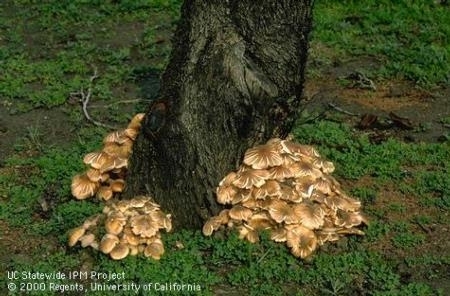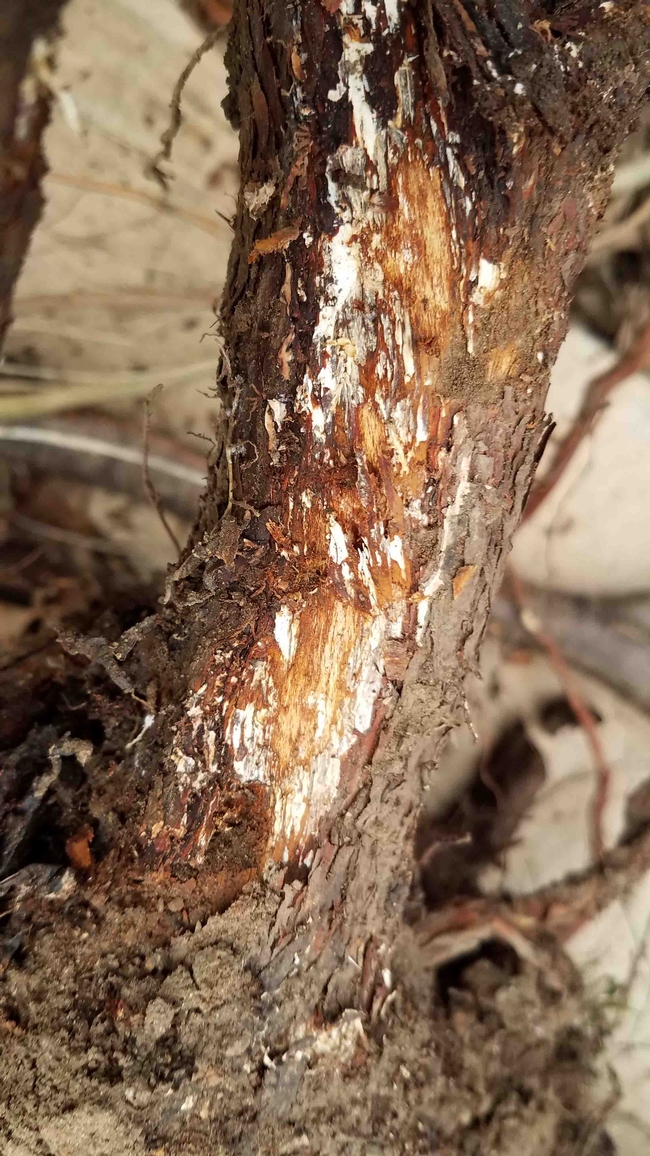The fungal disease “oak root rot” (Armillaria mellea) has evolved with California oaks and other native plants. It is parasitic on oaks and other plant species, but if these plants are growing in our environment of moist winters and dry summers, this fungus is normally kept in check. However, if summer irrigation is provided, Armillaria can become an aggressive, deadly pathogen. Armillaria is an opportunist that will also attack plants that are under stress either by damage to the roots or because of improper watering. Ironically water stress can be due to either drought or overwatering. In addition to oaks, woody plants that are susceptible to oak root rot include Escallonia, Butterfly Bush, Blue Blossom, Lilac, several types of Azaleas, and some Maples. Susceptible herbaceous perennials include begonias, carnations, daffodils, dahlias, geraniums, and peonies. Woody plants that are resistant to Armillaria include many species of Maple, Tree-of-Heaven, Madrone, Boxwood, Tree Anemone, Western Redbud, Holly, and many species of Pine. A more complete list of both resistant and susceptible plants can be found at Plants Resistant or Susceptible to The Oak Root Fungus.

Armillaria is always associated with wood; it does not live independently in the soil. Armillaria spreads from plant to plant when a root from an uninfected plant grows into the fungal mycelium, or when specialized fungal structures called rhizomorphs bridge a short distance (less than one inch) between a diseased root and an adjacent healthy plant's root. Once Armillaria comes in contact with a living root, it dissolves the bark and decays the wood. Although the interaction of environmental factors is not completely understood, it appears that high soil moisture, high concentrations of Armillaria, and close plant spacing are key factors that favor the spread of oak root fungus.

The Master Gardeners Fall 2021 Workshop Series is in Full Swing! Upcoming workshops include When to Control for Pests; a four-part series on Landscaping for a Future with Fire; Gardening with Chickens; Espalier Gardening; and Tool Care with Rob Fanno from Fanno Saw Works in Chico. Most workshops are in person, following Covid safety protocols, with a limited number of participants. The series on Landscaping for a Future with Fire will be conducted via Zoom. All workshops are free and take place in the morning; none are more than two hours long. Registration is required.
Plant Sale! The Master Gardeners will hold their Fall 2021 Plant Sale on October 30, from 9am to 1pm at the Demonstration Garden at Patrick Ranch. Along with the Plant Sale, there will be two workshops: “Gardening with Natives” at 10am and “Berry and Grape Gardening” at 11am. No registration is required for the workshops; Covid safety protocols will be followed.
UC Master Gardeners of Butte County are part of the University of California Cooperative Extension (UCCE) system. To learn more about us and our upcoming events, and for help with gardening in our area, visit our visit our website. If you have a gardening question or problem, email the Hotline at mgbutte@ucanr.edu(preferred) or call (530) 538-7201.